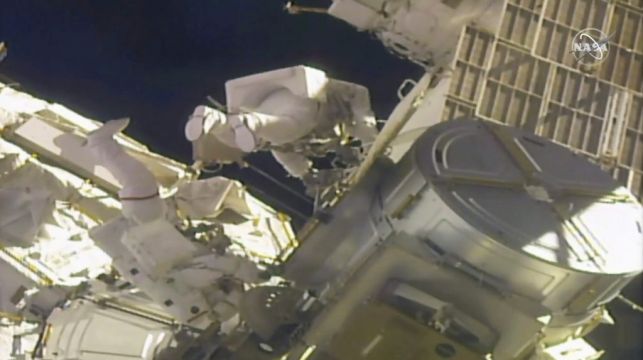A pair of Nasa astronauts went on their second spacewalk in under a week to complete a four-year effort to modernise the International Space Station’s power grid.
Over the weekend, flight controllers in Houston used the station’s big robot arm to replace the last pair of old-style batteries with a single better-quality one.
Astronauts Mike Hopkins and Victor Glover put the finishing touches on this newest lithium-ion battery to complete a series of spacewalks that began in 2017.
“Beautiful day. Let’s go for a walk outside,” Mission Control radioed as the spacewalk got off to a late start.
The space station is now equipped with 24 lithium-ion batteries to store power collected by the solar panels.
The big, boxy batteries, surpassing 400lb (180kg) each, provide electricity for the orbiting lab when it is on the night side of Earth.
✅ Final adapter plate installed on the @Space_Station. Today's spacewalk will wrap up battery replacement work to change out batteries for 8 power channels used to route electricity on the station. Upgrades have been carried out in a series of spacewalks over the past 4 years. pic.twitter.com/Gmg7TmPA0s
— NASA (@NASA) February 1, 2021
They are so powerful that only half as many are needed as the old nickel-hydrogen batteries they replaced.
The upgrade took longer than expected after one of the new batteries failed following its installation two years ago and had to be replaced.
In all, 14 spacewalks were needed to complete the battery work.
Nasa expects these batteries to last the rest of the space station’s operating life.
Other spacewalking chores on Monday for Mr Hopkins and Mr Glover include installing a new camera on the US Destiny lab and replacing parts in the camera system outside the station’s Japanese lab, named Kibo, or Hope in English.
During a spacewalk on Wednesday, the two astronauts made improvements to the European lab, Columbus.
Two more spacewalks will be conducted in about a month to get ready for additional solar panels set for delivery later this year.
Seven astronauts currently live on the space station: four Americans, two Russians and one Japanese.







